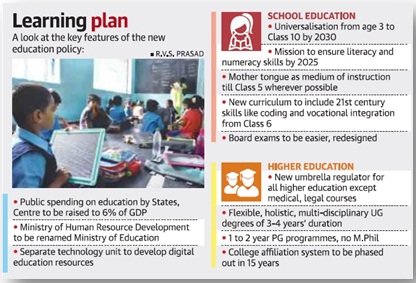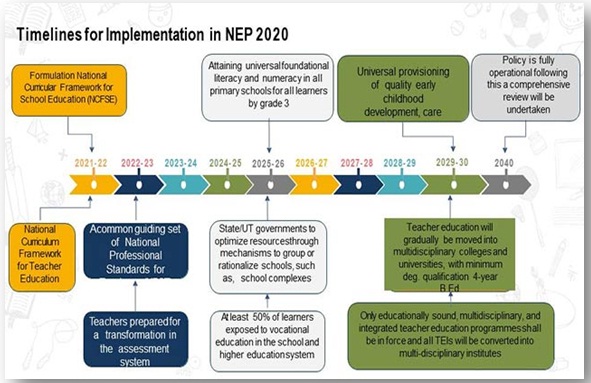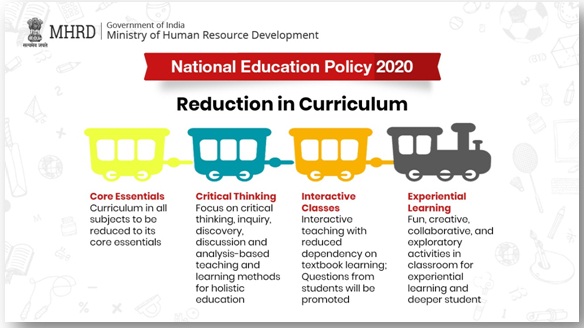|
Syllabus: Prelims GS Paper I : Current Events of National and International Importance; Economic and Social Development
Mains GS Paper II : Issues Relating to Development and Management of Social Sector/Services relating to Health, Education, Human Resources.
|
Context
The Union Cabinet approved a new National Education Policy on July 29, after a 34-year gap. Previously two education policies had already been introduced by the Union Government. Earlier on May 1, Prime Minister Narendra Modi had reviewed the NEP- 2020, for which draft was prepared by a panel of experts led by former Indian Space Research Organisation (ISRO) chief K Kasturirangan. The NEP 2020 aims at making “India a global knowledge superpower”. The National Education Policy, 2020 is meant to provide an overarching vision and comprehensive framework for both school and higher education across the country. It is only a policy, not a law; implementation of its proposals depends on further regulations by both States and the Centre as education is in the Concurrent List.
Key proposals of the Policy
School Education :
- The NEP proposes to change the school curricular structure from the current 10+2 (Class 1-10 of general education followed by two years of higher secondary school with specialised subjects) with a 5+3+3+4 structure, thus bringing children from ages 3 to 5 years within the formal education system for the first time, and ensuring curricular continuity in the last four years.
- A National Mission on Foundational Literacy and Numeracy;
- Free breakfasts being added to free lunches in government schools;
- Vocational education along with internships from Class 6;
- Proposed redesign of the board examinations are some other major initiatives for school education.
Higher Education:
- For higher education, a new umbrella regulator has been proposed with separate verticals for regulation, standard setting, accreditation and funding. It will absorb arts and science, technical and teacher education into its fold, replacing several existing regulatory bodies.
- Top foreign universities will be allowed to set up campuses in India.
- For students, the biggest change may be the introduction of four-year undergraduate degrees, with options for entry and exit at various stages, a credit transfer system, and the abolition of the M. Phil programme.
- It also aims to double the Gross Enrolment Ratio in higher education, including vocational education, from 26.3% in 2018 to 50% by 2035.
Use of Technology:
- Technology to be used in
- Education Planning
- Teaching Learning & Assessment
- Administration & Management
- Regulation- Self Disclosure & Minimum Human Interface
- Increasing Access for Disadvantaged Groups
- Divyang Friendly Education Software
- e-Content in Regional Language
- Virtual Labs
- National Educational Technology Forum (NETF)

The Bumpy ride Ahead
- Some of the proposals require legal changes. The draft Higher Education Commission of India Bill has been languishing in the Ministry for over a year, but is likely to be published for feedback by September. The proposal for a Board of Governors for universities may also require amendments of the Central and State Universities Acts. A Cabinet note has already been moved to set up the National Research Foundation as a trust under the government, but in order to make it a fully autonomous body, an Act may be required.
- Others require funding. Free breakfasts can only be considered in the next academic year if a budget allocation is made to cover it. The process of converting affiliated colleges into degree granting autonomous institutions and then further into fully fledged universities is estimated to take at least 15 years, as the Centre will have to provide financial assistance for this purpose.
- The proposal to make the mother tongue the medium of instruction till Class 5, which has stirred up the fiercest debates, is dependent on State governments, according to the Education Minister, who would not even confirm that the policy will be implemented by centrally-run schools.
Some Important Issues
- The National Education Policy 2020 announced by the Ministry of Human Resource Development sets for itself the goal of transforming the system to meet the needs of 21st Century India.
- In a federal system, any educational reform can be implemented only with support from the States, and the Centre has the giant task of building a consensus on the many ambitious plans. The policy, inter alia, aims to eliminate problems of pedagogy, structural inequities, access asymmetries and rampant commercialisation.
- The NEP 2020 is the first omnibus policy after the one issued in 1986, and it has to contend with multiple crises in the system. It is no secret that primary schools record shockingly poor literacy and numeracy outcomes, dropout levels in middle and secondary schools are significant, and the higher education system has generally failed to meet the aspirations for multi-disciplinary programmes.
- Progress on these crucially depends on the will to spend the promised 6% of GDP as public expenditure on education.
- The policy also says that wherever possible, the medium of instruction in schools until at least Class 5, but preferably until Class 8 and beyond, will be the home language or mother tongue or regional language. This is a long-held view, and has its merits, although in a large and diverse country where mobility is high, the student should have the option to study in the language that enables a transfer nationally. English has performed that role due to historical factors.
Good Points in NEP
- There are some good elements to the NEP 2020 that will generate little friction, and need only adequate resourcing.
- Provision of an energy-filled breakfast, in addition to the nutritious mid-day meal, to help children achieve better learning outcomes, is one.
- Bag-less days will be encouraged throughout the year for various types of enrichment activities involving arts, quizzes, sports, and vocational crafts.
- Creation of ‘inclusion funds’ to help socially and educationally disadvantaged children pursue education is another.
- Curriculum content will be reduced in each subject to its core essentials, and make space for critical thinking and more holistic, inquiry-based, discovery-based, discussion-based, and analysis-based learning.

Where the policy fails to show rigour, however, is on universalisation of access, both in schools and higher education; the Right to Education needs specific measures to succeed. Moreover, fee regulations exist in some States even now, but the regulatory process is unable to rein in profiteering in the form of unaccounted donations. The idea of a National Higher Education Regulatory Council as an apex control organisation is bound to be resented by States. Similarly, a national body for aptitude tests would have to convince the States of its merits. Among the many imperatives, the deadline to achieve universal literacy and numeracy by 2025 should be a top priority as a goal that will crucially determine progress at higher levels.
Connecting the dots
Preliminary Examination
National Education Policy 2020 aims to double the Gross Enrolment Ratio in higher education, including vocational education to 50% by the year
(a) 2025
(b) 2030
(c) 2040
(d) None of the above
Main Examination
Elaborate the need for the Government to bring out the New Education Policy. What are the challenges to implement this policy?



